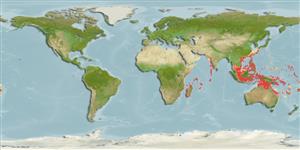Common names from other countries
Environment: milieu / climate zone / depth range / distribution range
Ökologie
seewasser riff-verbunden; tiefenbereich 8 - 90 m (Ref. 90102). Tropical
Indo-West Pacific: known from scattered localities from off Zanzibar to New Caledonia.
Size / Gewicht / Alter
Maturity: Lm ? range ? - ? cm
Max length : 10.0 cm TL Männchen/unbestimmt; (Ref. 9710)
Rückenflossenstacheln (insgesamt): 13; Rückenflossenweichstrahlen (insgesamt): 8; Afterflossenstacheln 3; Afterflossenweichstrahlen: 6. Recognized by the large rounded head and deeply incised membranes of the spinous part of the dorsal fin (Ref. 48635).
Inhabits silty coastal reefs (Ref. 9710); also in sheltered sand habitats in coastal bays and deep offshore. Uncommon and mainly known from prawn trawling grounds. Nocturnal, coming out on dusk, usually buries itself in the sand during the day (Ref. 48635).
Life cycle and mating behavior
Geschlechtsreife | Fortpflanzung | Ablaichen | Eier | Fecundity | Larven
Randall, J.E., G.R. Allen and R.C. Steene, 1990. Fishes of the Great Barrier Reef and Coral Sea. University of Hawaii Press, Honolulu, Hawaii. 506 p. (Ref. 2334)
IUCN Rote Liste Status (Ref. 130435)
Warning: mysqli::__construct(): (HY000/1040): Too many connections in /var/www/html/includes/func_getlabel.php on line 46
Can't connect to MySQL database (fbapp). Errorcode: Too many connections
